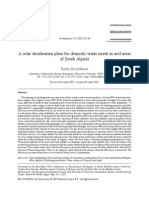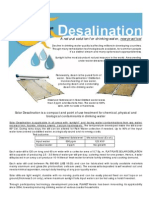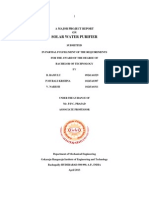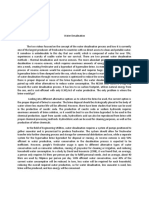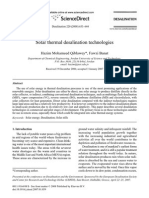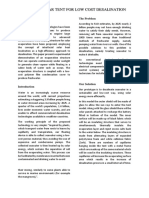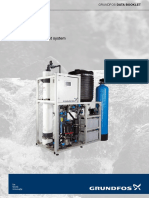0 ratings0% found this document useful (0 votes)
62 viewsSolar Water Distillator
Solar Water Distillator
Uploaded by
Aniket670Solar distillation is a simple process that uses solar energy to purify brackish water for drinking. It works by evaporating water using heat from the sun, then condensing the vapor to produce pure distilled water. The process removes salts and other impurities. A basic solar distillation plant consists of a basin to hold the saline water, a clear covering to allow sunlight to pass through and heat the water, and a trough to collect the distilled water. It is a low-cost option to produce small amounts of drinking water, especially in arid areas without access to fresh water sources.
Copyright:
© All Rights Reserved
Available Formats
Download as DOCX, PDF, TXT or read online from Scribd
Solar Water Distillator
Solar Water Distillator
Uploaded by
Aniket6700 ratings0% found this document useful (0 votes)
62 views5 pagesSolar distillation is a simple process that uses solar energy to purify brackish water for drinking. It works by evaporating water using heat from the sun, then condensing the vapor to produce pure distilled water. The process removes salts and other impurities. A basic solar distillation plant consists of a basin to hold the saline water, a clear covering to allow sunlight to pass through and heat the water, and a trough to collect the distilled water. It is a low-cost option to produce small amounts of drinking water, especially in arid areas without access to fresh water sources.
Original Description:
The book is about.How solar water distillator works.
Original Title
Solar water distillator
Copyright
© © All Rights Reserved
Available Formats
DOCX, PDF, TXT or read online from Scribd
Share this document
Did you find this document useful?
Is this content inappropriate?
Solar distillation is a simple process that uses solar energy to purify brackish water for drinking. It works by evaporating water using heat from the sun, then condensing the vapor to produce pure distilled water. The process removes salts and other impurities. A basic solar distillation plant consists of a basin to hold the saline water, a clear covering to allow sunlight to pass through and heat the water, and a trough to collect the distilled water. It is a low-cost option to produce small amounts of drinking water, especially in arid areas without access to fresh water sources.
Copyright:
© All Rights Reserved
Available Formats
Download as DOCX, PDF, TXT or read online from Scribd
Download as docx, pdf, or txt
0 ratings0% found this document useful (0 votes)
62 views5 pagesSolar Water Distillator
Solar Water Distillator
Uploaded by
Aniket670Solar distillation is a simple process that uses solar energy to purify brackish water for drinking. It works by evaporating water using heat from the sun, then condensing the vapor to produce pure distilled water. The process removes salts and other impurities. A basic solar distillation plant consists of a basin to hold the saline water, a clear covering to allow sunlight to pass through and heat the water, and a trough to collect the distilled water. It is a low-cost option to produce small amounts of drinking water, especially in arid areas without access to fresh water sources.
Copyright:
© All Rights Reserved
Available Formats
Download as DOCX, PDF, TXT or read online from Scribd
Download as docx, pdf, or txt
You are on page 1of 5
NESPRO RENEWABLE ENERGY SOLUTIONS
S 1 S11/1A, Nataraj Complex, Wing A/1, Near Bank of Maharashtra,
Teen
1 Hatti
1 Chouk, Chavan Nagar, Dhankawadi, Pune - 411
1 043
1
N
o.
SOLAR DISTILLATION PLANT
Introduction
Solar distillation is a relatively simple treatment of brackish (i.e. contain
dissolved salts) water supplies. Distillation is one of many processes that can be
used for water purification and can use any heating source. Solar energy is a low
tech option. In this process, water is evaporated, using the energy of the sun then
the vapour condenses as pure water. This process removes salts and other
impurities. Solar distillation is used to produce drinking water or to produce pure
water for lead acid batteries, laboratories, hospitals and in producing commercial
products such as rose water. It is recommended that drinking water has 100 to
1000 mg/l of salt to maintain electrolyte levels and for taste. Some saline water
may need to be added to the distilled water for acceptable drinking water. Solar
water distillation is a very old technology. An early large-scale solar still was built
in 1872 to supply a mining community in Chile with drinking water. It has been
used for emergency situations including the introduction of inflatable stills for life
boats by the navy. There are a number of other approaches to desalination, such
as photovoltaic powered reverse-osmosis, for which small-scale commercially
available equipment is available; solar distillation has to be compared with these
options to determine its appropriateness to any situation. If treatment of polluted
water is required rather than desalination, slow sand filtration is a low cost option.
Fig.1. Main inputs and outputs in Desalination Process
Energy requirements for water distillation
The energy required to evaporate water, called the latent heat of vaporisation
of water, is 2.26Megajouls per kilogram (MJ/kg). This means that to produce 1
litre (i.e. 1 kg as the density of water is 1 kg/ litre) of pure water by distilling
brackish water requires a heat input of 2.26 MJ. This does not allow for the
efficiency of the system used which will be less than 100%, or for any recovery of
latent heat that is rejected when the water vapour is condensed. It should be noted
that, although 2.26 MJ/kg or 2260 kJ/kg is required to evaporate water, to pump
water through 20 m head requires only 0.2 kJ/kg. Distillation is therefore normally
considered only where there is no local source of fresh water that can be easily
pumped or lifted.
How does it work
Fig.2. Example of Solar Distillation Process
Solar desalination is generally used for small-scale operations. Although the
designs of solar distillation units vary greatly, the basic principle is the same: that
the sun provides energy to evaporate freshwater from saline water. In solar
distillation, the water vapour formed from the evaporation process condenses on a
clear glass or plastic covering and is collected as freshwater in a condensate
trough. The covering is used to both transmit radiant energy and allow water
vapour to condense on its interior surface. The salt and un-evaporated water left
behind in the still basin form the brine solution that must be discarded
appropriately.
Solar distillation is often used in arid regions where safe freshwater is not
available. Solar distillation units produce differing amounts of freshwater,
according to their design and geographic location.
Actual Site Photographs:
Video links
https://www.youtube.com/watch?v=GrPRnaS449w
https://www.youtube.com/watch?v=zW3C1RRulmg
https://www.youtube.com/watch?v=gQAq9CNvE9Q
You might also like
- The Orthodox Keynesian SchoolDocument22 pagesThe Orthodox Keynesian Schoolasjad67% (3)
- API 1169 - Prep Test #2: Written by Dale Honn, P.E., P.L.SDocument48 pagesAPI 1169 - Prep Test #2: Written by Dale Honn, P.E., P.L.SHeartyscorpion50% (2)
- Water Sewage Water Purification Using Solar Distillation SystemDocument37 pagesWater Sewage Water Purification Using Solar Distillation Systempramo_dassNo ratings yet
- DesalinationDocument37 pagesDesalinationHans Galang100% (1)
- Solar Distillation - GSR WordDocument5 pagesSolar Distillation - GSR WordGowri ShankarNo ratings yet
- Purification of Water by Solar Energy: Department of Renewable Energy, University College of Engineering, KotaDocument7 pagesPurification of Water by Solar Energy: Department of Renewable Energy, University College of Engineering, Kotayatharth sharmaNo ratings yet
- Water DesalinationDocument8 pagesWater DesalinationMehwishNo ratings yet
- Research Paper Solar Still PDFDocument10 pagesResearch Paper Solar Still PDFMd IrfanNo ratings yet
- Distillation and DesalinationDocument10 pagesDistillation and DesalinationMark Anthony HenryNo ratings yet
- JETIR1805785Document5 pagesJETIR1805785Sagar GaikwadNo ratings yet
- Ijaret: International Journal of Advanced Research in Engineering and Technology (Ijaret)Document16 pagesIjaret: International Journal of Advanced Research in Engineering and Technology (Ijaret)IAEME PublicationNo ratings yet
- Solar StillDocument21 pagesSolar StillAnalyst NamalNo ratings yet
- Seminar Solar DistillationDocument14 pagesSeminar Solar DistillationBharath BharmaNo ratings yet
- Design and Performance Analysis of A Modified Vacuum Single Basin Solar StillDocument8 pagesDesign and Performance Analysis of A Modified Vacuum Single Basin Solar StillRaamesh GaikwaadNo ratings yet
- "Solar Still": Rajasthan Technical University, KotaDocument43 pages"Solar Still": Rajasthan Technical University, KotaHada NanuNo ratings yet
- Designing A Next Generation Solar Crystallizer For Real Seawater Brine Treatment With Zero Liquid DischargeDocument10 pagesDesigning A Next Generation Solar Crystallizer For Real Seawater Brine Treatment With Zero Liquid DischargeSeksan KhamkaewNo ratings yet
- Factsheet DesalinationDocument3 pagesFactsheet Desalinationblumunchie100% (1)
- Design and Fabrication of Water Purification System Using Solar EnergyDocument2 pagesDesign and Fabrication of Water Purification System Using Solar EnergyMuzaffarNo ratings yet
- DesalinationDocument2 pagesDesalinationrabiawaqar85No ratings yet
- FABRICATION OF SOLAR THERMAL BATTERY WATER DISTILLATION IN SALT WATER 2nd REVIEWDocument14 pagesFABRICATION OF SOLAR THERMAL BATTERY WATER DISTILLATION IN SALT WATER 2nd REVIEWAnonymous Clyy9NNo ratings yet
- DesalinationDocument2 pagesDesalinationnoha nabilNo ratings yet
- Solar StillDocument1 pageSolar StillHaris PermadiNo ratings yet
- Solar Water Treatment SystemDocument27 pagesSolar Water Treatment SystemSantoshi AgrawalNo ratings yet
- Solar Energy Based Purificationof Sea Water ADetailed ReviewDocument6 pagesSolar Energy Based Purificationof Sea Water ADetailed Reviewnn0566419No ratings yet
- DesalinationDocument10 pagesDesalinationAmirul AizatNo ratings yet
- Chemical Students PresentationDocument17 pagesChemical Students PresentationManpreetSaranNo ratings yet
- 2002 A Solar Desalination Plant For Domestic Water Needs in Arid Areas of South AlgeriaDocument5 pages2002 A Solar Desalination Plant For Domestic Water Needs in Arid Areas of South AlgeriaRahul TripathiNo ratings yet
- Solar Still - Distillation: Pdhonline Course E425 (1 PDH)Document11 pagesSolar Still - Distillation: Pdhonline Course E425 (1 PDH)Ravichandran GNo ratings yet
- Mini CapstoneDocument10 pagesMini CapstoneNathalia SantiagoNo ratings yet
- Main Report 7th SemDocument31 pagesMain Report 7th Semdjdeepu2000No ratings yet
- Chapter II.Document18 pagesChapter II.Paulo GalleraNo ratings yet
- RRLDocument19 pagesRRLJBSNo ratings yet
- Environmental Engineering Assignment ON Desalination of WaterDocument17 pagesEnvironmental Engineering Assignment ON Desalination of WaterAditya JalanNo ratings yet
- Solar Water Purification System: Presented by Rohit Sen (Me)Document17 pagesSolar Water Purification System: Presented by Rohit Sen (Me)Santoshi AgrawalNo ratings yet
- DesalinationDocument2 pagesDesalinationShailesh PrajapatiNo ratings yet
- Solar Water Purifier 1Document40 pagesSolar Water Purifier 1Srini0% (1)
- Solar Water Distillation - Safe Drinking Water FoundationDocument6 pagesSolar Water Distillation - Safe Drinking Water FoundationRudolph ScheepersNo ratings yet
- Desalination Explore ManualDocument40 pagesDesalination Explore ManualMOHAMED ELRAWYNo ratings yet
- Solar Water Distillation SystemDocument44 pagesSolar Water Distillation SystemMahesh VishwakarmaNo ratings yet
- My Final MathafodiDocument51 pagesMy Final Mathafodiyatharth sharmaNo ratings yet
- REMF-191 Design and Fabrication of Solar Water PurifierDocument3 pagesREMF-191 Design and Fabrication of Solar Water PurifierretechNo ratings yet
- Desalination Methods For Producing Drinking Water: Source WatersDocument8 pagesDesalination Methods For Producing Drinking Water: Source Watersحنين الخميسيNo ratings yet
- Water Desalination - VedejaDocument3 pagesWater Desalination - VedejaJOHN WILLIAM VEDEJANo ratings yet
- Solar Water Distilator ProjectDocument34 pagesSolar Water Distilator Projectas1510No ratings yet
- Design of Solar Powered Desalination Plant: AbstractDocument5 pagesDesign of Solar Powered Desalination Plant: AbstractMustafaNo ratings yet
- Paper 56Document13 pagesPaper 56Anas HamadNo ratings yet
- SOLAR WATER DISTILLATION SYSTEM MAIN Final1Document55 pagesSOLAR WATER DISTILLATION SYSTEM MAIN Final1Jjp ParmarNo ratings yet
- 0 AbsDocument2 pages0 AbsSilvers RayleighNo ratings yet
- Solar Thermal Desalination Technologies: Hazim Mohameed Qiblawey, Fawzi BanatDocument12 pagesSolar Thermal Desalination Technologies: Hazim Mohameed Qiblawey, Fawzi BanatAsmaa RamadanNo ratings yet
- DesalinationDocument6 pagesDesalinationpaularj2601No ratings yet
- Solar Still Research PaperDocument8 pagesSolar Still Research PaperGopakumar NairNo ratings yet
- Acquaquantum: Solar Humidification-Dehumidification Desalination (HD) UnitDocument3 pagesAcquaquantum: Solar Humidification-Dehumidification Desalination (HD) UnitbrujieNo ratings yet
- File PDFDocument3 pagesFile PDFVicky RanaNo ratings yet
- Solar Pond TechnologyDocument16 pagesSolar Pond TechnologyVinod MhetreNo ratings yet
- Solar Water PurifierDocument42 pagesSolar Water PurifierAakash DindigulNo ratings yet
- Solar Energy ApplicationDocument9 pagesSolar Energy ApplicationatulsemiloNo ratings yet
- Techno Water Pres 2Document12 pagesTechno Water Pres 2Joe BabNo ratings yet
- Group 2 PPGDocument12 pagesGroup 2 PPGdacudaoroy139No ratings yet
- Solar Stills For Desalination of Water in Rural Households: Amitava BhattacharyyaDocument10 pagesSolar Stills For Desalination of Water in Rural Households: Amitava BhattacharyyaTrimo Wahyu Bimantoro100% (1)
- Aquarium Supply Buyers Guide - Best Practices for Keeping Fish RevealedFrom EverandAquarium Supply Buyers Guide - Best Practices for Keeping Fish RevealedRating: 3 out of 5 stars3/5 (1)
- 5-Latest EIC-B-1001-0 ( - PVR - Series Single Vane Pumps)Document29 pages5-Latest EIC-B-1001-0 ( - PVR - Series Single Vane Pumps)RAYNo ratings yet
- CD74HC7046A, CD74HCT7046A: Features DescriptionDocument22 pagesCD74HC7046A, CD74HCT7046A: Features DescriptionDanielNo ratings yet
- UK Game Developer LocationsDocument2 pagesUK Game Developer LocationsDaniel Townsend100% (4)
- Africa Grant Funding: Any African NationalDocument2 pagesAfrica Grant Funding: Any African NationalFampau CoulibalyNo ratings yet
- Speaking IIDocument3 pagesSpeaking IITEOH EAK SOONNo ratings yet
- Accepted Manuscript: 10.1016/j.yrtph.2015.06.016Document56 pagesAccepted Manuscript: 10.1016/j.yrtph.2015.06.016Irshaan SyedNo ratings yet
- Study Aid Questions: Fill in The BlanksDocument11 pagesStudy Aid Questions: Fill in The Blanksrebira endrisNo ratings yet
- Sa 479Document12 pagesSa 479negg 348100% (1)
- Econ 101 A Final PracticeDocument5 pagesEcon 101 A Final PracticeateiskaNo ratings yet
- Daily Calendar Science 7: Notre Dame of Salaman College, IncDocument5 pagesDaily Calendar Science 7: Notre Dame of Salaman College, IncGYAN ALVIN ANGELO BILLEDONo ratings yet
- Completed Water Safety Risk Assessment ExampleDocument6 pagesCompleted Water Safety Risk Assessment ExampleArchana SoorajNo ratings yet
- Spouses Roque Vs AguadoDocument3 pagesSpouses Roque Vs AguadoMary dela RosaNo ratings yet
- Grundfosliterature 5606056Document22 pagesGrundfosliterature 5606056Ja AcostaNo ratings yet
- Ems System For Ip DslamDocument50 pagesEms System For Ip DslamPedroNo ratings yet
- MATH 115: Lecture XXIII NotesDocument3 pagesMATH 115: Lecture XXIII NotesDylan C. BeckNo ratings yet
- Employment Contract TemplateDocument7 pagesEmployment Contract Templatejeannajam06No ratings yet
- 2000 Whatsapp Group Links Active Join WH PDFDocument4 pages2000 Whatsapp Group Links Active Join WH PDFWilly ChalNo ratings yet
- Structured Packing BrochureDocument12 pagesStructured Packing BrochureMoad Bouzida100% (1)
- Introduction To FCC Rules and Equipment Authorization ProgramDocument43 pagesIntroduction To FCC Rules and Equipment Authorization ProgramRen YagamiNo ratings yet
- Q4 2013 SA8000 Certs List, Public ListDocument240 pagesQ4 2013 SA8000 Certs List, Public ListDhananjayan GopinathanNo ratings yet
- Structure by Vivek GuptaDocument637 pagesStructure by Vivek GuptajamunaNo ratings yet
- History of Basketball and VolleyballDocument1 pageHistory of Basketball and VolleyballBreeNo ratings yet
- Caraig, Danica G. - LP GRADE 9 (Joint Variation)Document7 pagesCaraig, Danica G. - LP GRADE 9 (Joint Variation)caraigikayNo ratings yet
- General Information Cis375 Fall2015Document6 pagesGeneral Information Cis375 Fall2015abcNo ratings yet
- Documentation of Planning Cycle Part 1 N Part BDocument7 pagesDocumentation of Planning Cycle Part 1 N Part BOfficial WorkNo ratings yet
- Flowchart and AlgorithmDocument13 pagesFlowchart and AlgorithmAyush Das PurkayasthaNo ratings yet
- A. Jill Has Many Restaurants To Choose From For Her BirthdayDocument3 pagesA. Jill Has Many Restaurants To Choose From For Her Birthdayshincee23No ratings yet
- CARBOHYDRATE ABSORPTION (Ref)Document22 pagesCARBOHYDRATE ABSORPTION (Ref)NEERAJA S RAJNo ratings yet


























